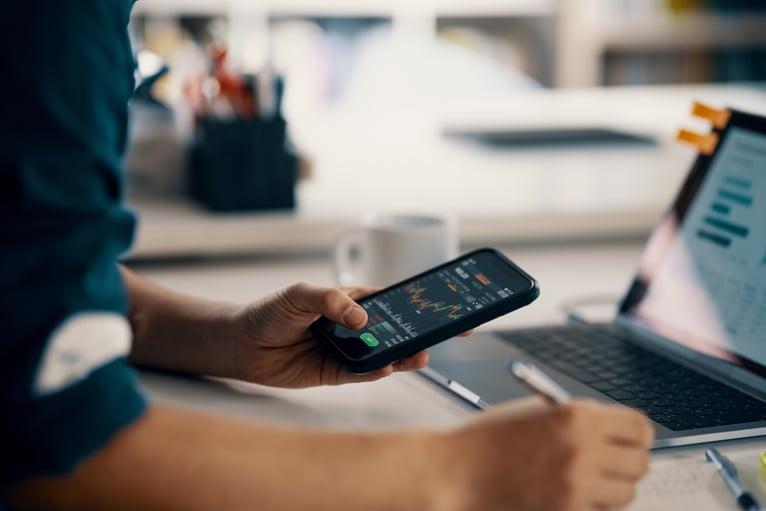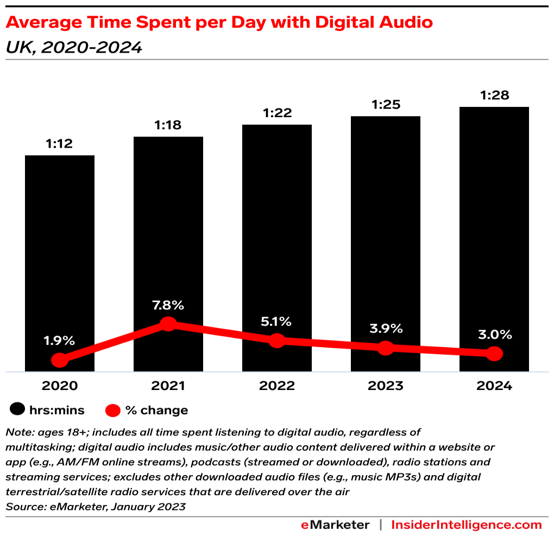The top 5 monetization tactics for digital audio publishers

Digital audio continues to evolve very quickly in today’s landscape as audiences tune into streaming radio, music playlists, and podcasts as their favorite ways to consume content, entertainment, and information. As we start 2023, Triton Digital, provider of the world’s leading programmatic audio marketplace, is seeing an increase of over 70% in programmatic audio impressions delivered compared to the same period 3 years ago in the European region. In 2022, the most popular live audio streaming format in Europe was Contemporary Hits, Pop, and Top 40. We saw Talk and News radio appear as the leading podcast formats for advertisers in 2022 and the top advertising categories were Shopping, Personal Finance, and Insurance.
While audio used to be a complimentary channel in media planning, it is now becoming an immensely popular format to use as podcast and streaming audio consumption continues to grow. The average time spent per day with digital audio is projected to reach 1 hour and 25 minutes in the UK alone in 2023. Marketers are leveraging programmatic audio as a hidden gem to communicate their messaging to a highly targeted audience.

Whether you are a radio broadcaster live streaming your stations digitally, a podcaster, music service, or in-game app developer, here are 5 programmatic advertising tactics you need to build revenue and successfully monetize your audio inventory.
1. Ensure there is healthy scale
Advertisers are looking to deliver impressions on quality inventory, and at scale. Creating and publishing outstanding audio content is time consuming and requires consistent effort behind the scenes. However, you can experiment with multiple stations, podcasts, or playlists across many genres to evaluate which ones can draw in a big audience. Remember, most audio ads are sold on their contextual value, so make sure the content you are building has a recognizable and distinct listener demographic. You will need to find the balance between trending content, experimental topics, and niche formats. Popular content with strong marketing can capture a large audience base, but also think about serving a specific group of listeners who are hungry for content that is relevant to them. Seasonal content, episodic podcasts, and pop-up stations are some ideas to capture new audiences while keeping existing listeners entertained. In the digital audio world, you can quickly switch, add, and drop formats. There are opportunities and audiences for whichever direction you choose, so experiment and be creative!
2. AddressabilityWhere possible, you want to have addressable and targetable listeners in the programmatic bid request by passing advertising IDs (mobile device ad ID or web-based cookie). These ‘smart’ impressions are more valuable to the advertiser as they supply more data about the audience that significantly improves targeting capabilities from the DSP. CPM levels for smart impressions are up to three times higher than regular impressions. Speak to your technology partner and app developer to see how you can pass identifiers for your listeners.
3. Have a media kit ready
A great media kit can tell in 10 slides or less the type of audio content you have, your audience demographics, what makes your content unique, example ads, how to access through programmatic channels, and supported audio ad formats. Remember your media kit will be evaluated along with other publishers and platforms, so make sure its eye catching and presentable! When you add content or new features to your platform, be sure to keep this document up to date as well. You want to spotlight your best content and if you have case studies or testimonials from advertisers highlighting campaigns you have worked on in the past, it is even better!
4. Be ready to respond to programmatic buyers
For your media sales team, it is best to appoint a point of contact or a team to lead conversations with interested programmatic buyers. This team should have a thorough understanding of your audio inventory and audience, and some background in programmatic advertising. Audio is a specialized field, but not too far-fetched from other digital ad formats available in the market today. Empower this team with the right resources, support, and platform for them to maximize your programmatic revenue. They should be familiar with setting up deals on your platform, monitoring performance, optimizing yield, and generating reports. They will spearhead your programmatic strategy and will handle bringing in the money! The more proactive and up to date you are in the programmatic space, the more prepared you will be to field questions from potential advertisers.
5. Find the right programmatic partners
With the constant shift in digital advertising technology and privacy, finding the right partners can be challenging. With programmatic buying, buyer diversity helps to raise auction floor prices and provides you with a higher clearing price. Make sure you have access to as many ad networks and DSPs as possible. You should have the flexibility to execute the best revenue strategy with the tools at hand. Evaluate your technology and commercial partners to ensure that you have the best integrations, expertise, sales representations, and ultimately revenue yield so you can keep maximizing your monetization opportunities. Participate in industry events and conversations to stay up to date with the latest technology shifts and network with other publishers and specialists!
If you are an audio publisher seeking to monetize your digital audio inventory through programmatic, contact us through solutions@tritondigital.com for a chat!
Back to blog